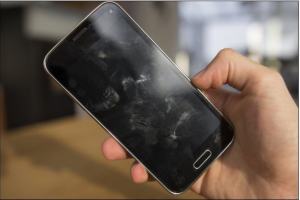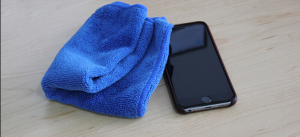Situatie
Your smartphone and other touch devices have a layer called an “oleophobic coating.” No matter how carefully you try to protect this, it wears away over time. Fortunately, you can restore it and make the touch screen feel like new again.
What Is an Oleophobic Coating?
When you first unwrap a new smartphone, one of the most striking things is how new and shiny the screen looks. This has surprisingly little to do with the lack of scratches and more to do with the fresh coat of oleophobic treatment on it.
From the first day you start using your smartphone, that coating starts to wear away. Using a screen protector is the only way you can really protect it. And if you apply a glass screen protector, it will also probably have an oleophobic coating.
The coating not only affects how your device looks, but also how it feels. Your fingers glide across a brand-new screen with ease, and there’s little in the way of friction to slow you down. It’s also easy to clean fingerprints and grease off the screen with a wipe.
Solutie
Pasi de urmat
As the coating wears away, fingerprints tend to hang around longer and require a more thorough cleaning. Oil or water that used to bead up into smaller droplets now sits on the screen and smears.
To test this, just put a drop of water on the screen. If it beads up and holds together in a sphere, the oleophobic coating is doing its job. However, if the water spreads and moves around the display in a big blob, you know the coasting has worn away.
The oleophobic coating isn’t vital for your device to work. Your phone will work just fine without it, and your screen isn’t any more likely to get scratched or broken. It just won’t look or feel as nice.
If your device is a year or two old, don’t be surprised to find that the oleophobic coating is completely gone. The more you use your phone, the faster it wears away.
Protecting the Oleophobic Coating
While this oil-repelling coating wears away through ordinary use, there are a few things you can do to help protect it. The most obvious thing you can do is never use an abrasive cleaner or detergent on the touch screen.
This includes, but is not limited to, the following:
- Windex or other window cleaners
- Bleach or other bleach-based cleaning agents
- Detergents, like washing powder or dishwashing liquid
- Creme cleansers
- Cutting agents, like T-Cut, or other polishes
Abrasive cleaners strip away the oleophobic coating entirely. Some might even damage the screen or leave it streaky or cloudy. Fortunately, there are safe ways you can clean your smartphone and other touch screen devices.
First, always start by wiping your device with a soft, lint-free cloth. Dampen it with water and remove any visible dirt and grime. This is important because bacteria and other nasties cling to dirt.
To disinfect your smartphone, use an alcohol-based cleaning solution that contains a minimum of 60 percent ethanol or 70 percent isopropanol. Apple recommends you use 70 percent isopropyl alcohol wipes to clean iPhones, iPads, and other devices during the current coronavirus pandemic. You can apply the same instructions to modern Android phones made of similar materials.
Keep in mind that cleaning the screen this way might accelerate the rate of wear on the oleophobic coating. However, it’s necessary to sanitize your phone or tablet this way because you probably touch it hundreds of times per day. This is especially important if you hold your phone against your face during calls.
If you want to restore the touch screen to a like-new state, you can use some aftermarket products to do so.
Restoring the Oleophobic Coating
If you applied a glass screen protector to your device, you can just replace it to make your device feel new again. This is a cost-effective way of restoring your device to its former glory. It will help it retain its resale value, too.
For those who didn’t think ahead, you can buy an aftermarket oleophobic coating kit (like Fusso by Crystal Armor) and reapply it yourself. These kits cost around $10 or $20 for a single treatment, which is good for one device.
Keep in mind that instructions might vary, depending on the product. Always follow the instructions on the product.
Generally, the process is pretty straightforward. The following is a summary of how iFixit describes the process of restoring the oleophobic coating:
- Clean the screen with isopropyl alcohol until it’s free of grease and other dirt.
- Allow the alcohol to evaporate fully so the screen is completely dry.
- Place a ziplock bag over your finger (you’ll use it as a squeegee).
- Apply 10 to 15 drops of the liquid oleophobic coating to the screen.
- Immediately spread the liquid over the screen with your plastic-covered finger. (It dries fast, so be quick!)
- Let the coating cure for eight to 12 hours (ideally, overnight). Wipe off any excess residue with a soft cloth.
- Repeat this process as necessary, per the instructions on the product.
The more you repeat the process, the thicker the coating will be, and, thus, the longer it will last. Although the coating appears to dry quickly, you do need to leave it untouched for an extended period.
If you follow the instructions, though, there’s very little room for error. Your device will look and feel shiny and new again. You might even “fill in” some surface scratches so they’re less noticeable.
Oil Be Back
Again, remember your newly restored oleophobic coating won’t last forever. It’s also unlikely a third-party coating will last quite as long as the one applied at the factory. However, they should be similar in terms of look and feel.
You can also use an oleophobic treatment on all glass touch screens, including smartwatches, tablets, and some fitness trackers. If you’re thinking of going the screen protector route for your next device, it’s helpful to note the Gorilla Glass on most new phones is tougher than many common metals



Leave A Comment?